| Listing 1 - 7 of 7 |
Sort by
|

ISBN: 1135923949 1135923957 1280107049 0203997727 9780203997727 9780415969000 041596900X 9780415969017 0415969018 9786610107049 6610107041 041596900X 0415969018 9781135923952 9781135923907 1135923906 9781135923945 Year: 2005 Publisher: New York : Routledge,
Abstract | Keywords | Export | Availability | Bookmark
 Loading...
Loading...Choose an application
- Reference Manager
- EndNote
- RefWorks (Direct export to RefWorks)
Sound transformed not only the Hollywood film industry, but all of world cinema. This text examines how the arrival of sound brought a boom to the industry and why its social impact deepened in complexity.
Sound motion pictures --- Motion picture industry --- Moving-pictures, Talking --- Talkies --- Talking motion pictures --- Motion pictures --- History.
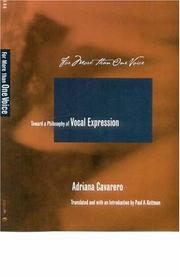
ISBN: 0804767300 1423716558 9781423716556 9780804749541 080474954X 9780804749558 0804749558 9780804767309 Year: 2005 Publisher: Stanford, Calif. : Stanford University Press,
Abstract | Keywords | Export | Availability | Bookmark
 Loading...
Loading...Choose an application
- Reference Manager
- EndNote
- RefWorks (Direct export to RefWorks)
The human voice does not deceive. The one who is speaking is inevitably revealed by the singular sound of her voice, no matter "what" she says. We take this fact for granted—for example, every time someone asks, over the telephone, "Who is speaking?" and receives as a reply the familiar utterance, "It's me." Starting from the given uniqueness of every voice, Cavarero rereads the history of philosophy through its peculiar evasion of this embodied uniqueness. She shows how this history—along with the fields it comprehends, such as linguistics, musicology, political theory, and studies in orality—might be grasped as the "devocalization of Logos," as the invariable privileging of semantike over phone, mind over body. Female figures—from the Sirens to the Muses, from Echo to opera singers—provide a crucial counterhistory, one in which the embodied voice triumphs over the immaterial semantic. Reconstructing this counterhistory, Cavarero proposes a "politics of the voice" wherein the ancient bond between Logos and politics is reconfigured, and wherein what matters is not the communicative content of a given discourse, but rather who is speaking.
Speech --- Language and languages --- Philosophy --- Talking --- Oral communication --- Phonetics --- Voice --- Philosophy. --- History.
Book
ISBN: 1280313110 9786610313112 3540282491 Year: 2005 Publisher: Berlin : Springer,
Abstract | Keywords | Export | Availability | Bookmark
 Loading...
Loading...Choose an application
- Reference Manager
- EndNote
- RefWorks (Direct export to RefWorks)
In recent years birdsong has developed into an extremely interesting problem for researchers in several branches of the scientific community. The reason is that of the approximately 10,000 species of birds known to exist, some 4000 share with humans (and just a few other species in the animal kingdom) a remarkable feature: their acquisition of vocalization requires a certain degree of exposure to a tutor. Between the complex neural architecture involved in the process and the song itself, stands a delicate apparatus that the bird must control with incredible precision. This book deals with the physical mechanisms at work in the production of birdsong, the acoustic effects that the avian vocal organ is capable of generating, and the nature of the neural instructions needed to drive it. The book provides fascinating reading for physicists, biologists and general readers alike.
Birds --- Birdsongs. --- Vocalization. --- Bird calls --- Bird-song --- Bird songs --- Animal sounds --- Songbirds --- Talking birds --- Neurobiology. --- Acoustics. --- Morphology (Animals). --- Biological and Medical Physics, Biophysics. --- Animal Anatomy / Morphology / Histology. --- Animal morphology --- Animals --- Body form in animals --- Zoology --- Morphology --- Neurosciences --- Biophysics. --- Biological physics. --- Animal anatomy. --- Animal anatomy --- Biology --- Physiology --- Biological physics --- Medical sciences --- Physics --- Anatomy
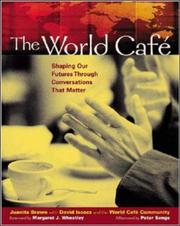
ISBN: 1576752585 1605092517 1282298852 9786612298851 9781605092515 9781605092669 1605092665 9781576752586 9781609940393 1609940393 9781282298859 9781576752586 6612298855 Year: 2005 Publisher: San Francisco, CA : Berrett-Koehler Publishers,
Abstract | Keywords | Export | Availability | Bookmark
 Loading...
Loading...Choose an application
- Reference Manager
- EndNote
- RefWorks (Direct export to RefWorks)
The World Cafe is a flexible, easy-to-use process for fostering collaborative dialogue, sharing mutual knowledge, and discovering new opportunities for action. Based on living systems thinking, this innovative approach creates dynamic networks of conversation that can catalyze an organization or community's own collective intelligence around its most important questions.Filled with stories of actual Cafe dialogues in business, education, government, and community organizations across the globe, this uniquely crafted book demonstrates how the World Cafe can be adapted to any setting or culture.
Communication in social action. --- Conversation -- Social aspects. --- Group facilitation. --- Conversation --- Social aspects. --- Talking --- Facilitation, Group --- Social facilitation --- Colloquial language --- Etiquette --- Oral communication --- Social action --- Interpersonal relations --- Community organization --- Organization theory --- Mass communications --- inspraak --- groepsdiscussies --- dialogen --- methoden van het sociaal werk --- participatie --- organisatieontwikkeling
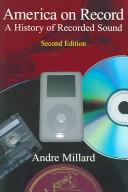
ISBN: 0521542812 9780521542814 9780511800566 9780521835152 9780511140525 0511140525 0521835151 0511800568 9780511139178 0511139179 0521835151 1316283925 0511137982 0511139756 0511140223 1322882029 9781316283929 9780511137983 9780511139758 9780511140228 Year: 2005 Publisher: Cambridge : Cambridge University Press,
Abstract | Keywords | Export | Availability | Bookmark
 Loading...
Loading...Choose an application
- Reference Manager
- EndNote
- RefWorks (Direct export to RefWorks)
With Thomas Edison's invention of the phonograph, the beautiful music that was the preserve of the wealthy became a mass-produced consumer good, cheap enough to be available to all. In 1877 Edison dreamed that one day there would be a talking machine in every home. America on Record: A History of Recorded Sound, first published in 2006, provides a history of sound recording from the first thin sheet of tinfoil that was manipulated into retaining sound to the home recordings of rappers in the 1980s and the high-tech studios of the 1990s. This book examines the important technical developments of acoustic, electric, and digital sound reproduction while outlining the cultural impact of recorded music and movies. This second edition updates the story, describing the digital revolution of sound recording with the rise of computers, Napster, DVD, MP3, and iPod.
Music --- Phonograph --- Sound recordings --- 534.85 --- 78 <73> --- 534.85 Sound recording and reproduction --- Sound recording and reproduction --- Gramophone --- Graphophone --- Record players --- Speaking-machines --- Talking-machines --- Sound --- 78 <73> Muziek--Verenigde Staten van Amerika. VSA. USA --- Muziek--Verenigde Staten van Amerika. VSA. USA --- History and criticism --- Recording and reproducing --- Equipment and supplies --- Phonograph. --- History and criticism.
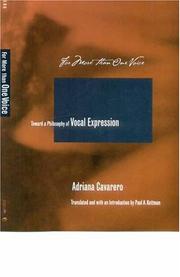
ISBN: 0804749558 9780804749558 080474954X Year: 2005 Publisher: Stanford: Stanford university press,
Abstract | Keywords | Export | Availability | Bookmark
 Loading...
Loading...Choose an application
- Reference Manager
- EndNote
- RefWorks (Direct export to RefWorks)
Speech --- Language and languages --- Philosophy --- History --- 767 --- Talking --- Oral communication --- Phonetics --- Voice --- Theorie van het theater en de film - Spreken, vertellen en schrijven. --- filosofie --- taal --- cultuurfilosofie --- linguistiek --- politiek --- spraak --- vrouwelijkheid --- vrouwen --- 130.2 --- Philosophical anthropology --- Speech - Philosophy --- Language and languages - Philosophy --- Philosophy - History --- 761.10 --- Theorie van het theater en de film - Dramaturgie --- 130.2. --- cultuurfilosofie. --- filosofie. --- linguistiek. --- politiek. --- spraak. --- taal. --- vrouwelijkheid. --- vrouwen. --- Theorie van het theater en de film - Dramaturgie. --- Philosophy. --- History.
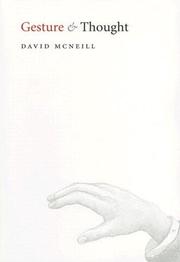
ISBN: 0226514633 9780226514635 0226514625 9780226514628 9786611965945 1281965944 0226514641 9780226514642 9781281965943 Year: 2005 Publisher: Chicago : University of Chicago Press,
Abstract | Keywords | Export | Availability | Bookmark
 Loading...
Loading...Choose an application
- Reference Manager
- EndNote
- RefWorks (Direct export to RefWorks)
Gesturing is such an integral yet unconscious part of communication that we are mostly oblivious to it. But if you observe anyone in conversation, you are likely to see his or her fingers, hands, and arms in some form of spontaneous motion. Why? David McNeill, a pioneer in the ongoing study of the relationship between gesture and language, set about answering this question over twenty-five years ago. In Gesture and Thought he brings together years of this research, arguing that gesturing, an act which has been popularly understood as an accessory to speech, is actually a dialectical component of language. Gesture and Thought expands on McNeill's acclaimed classic Hand and Mind. While that earlier work demonstrated what gestures reveal about thought, here gestures are shown to be active participants in both speaking and thinking. Expanding on an approach introduced by Lev Vygotsky in the 1930's, McNeill posits that gestures are key ingredients in an "imagery-language dialectic" that fuels both speech and thought. Gestures are both the "imagery" and components of "language." The smallest element of this dialectic is the "growth point," a snapshot of an utterance at its beginning psychological stage. Utilizing several innovative experiments he created and administered with subjects spanning several different age, gender, and language groups, McNeill shows how growth points organize themselves into utterances and extend to discourse at the moment of speaking. An ambitious project in the ongoing study of the relationship of human communication and thought, Gesture and Thought is a work of such consequence that it will influence all subsequent theory on the subject.
Psycholinguistics --- Semiotics --- Gesture --- Language and languages --- Sign language --- Speech --- Thought and thinking --- #KVHA:Cognitieve linguïstiek --- #KVHA:Lichaamstaal --- #KVHA:Psycholinguïstiek --- #KVHA:Taalkunde --- Mind --- Thinking --- Thoughts --- Educational psychology --- Philosophy --- Psychology --- Intellect --- Logic --- Perception --- Self --- Talking --- Oral communication --- Phonetics --- Voice --- Deaf --- Gesture language --- Signs and symbols --- Language, Psychology of --- Psychology of language --- Linguistics --- Foreign languages --- Languages --- Anthropology --- Communication --- Ethnology --- Information theory --- Meaning (Psychology) --- Philology --- Mudra --- Acting --- Body language --- Elocution --- Movement (Acting) --- Oratory --- Psychological aspects --- Gesture. --- Psycholinguistics. --- Thought and thinking. --- Speech. --- Sign language. --- Language and languages. --- Psycholinguistique --- gesturing, communication, conversation, linguistics, speech, language, lev vygotsky, thought, cognition, imagery, psycholinguistics, thinking, sign, age, gender, utterances, discourse, cognitive psychology, anthropology, kinetic, expression, embodiment, consciousness, dialectic, neurology, social context, function, mind and body, nonfiction. --- Cognition et langage --- Gestes
| Listing 1 - 7 of 7 |
Sort by
|

 Search
Search Feedback
Feedback About UniCat
About UniCat  Help
Help News
News